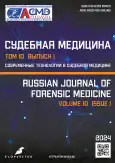Role of virtual reality in advancing forensic medical examination in cases of occupational safety violations: a review
- Authors: Kassenova S.O.1, Voyevodkin D.V.1
-
Affiliations:
- Academy of Law Enforcement Agencies Under the General Prosecutors Office of the Republic of Kazakhstan
- Issue: Vol 10, No 1 (2024)
- Pages: 99-112
- Section: Reviews
- URL: https://journals.rcsi.science/2411-8729/article/view/254431
- DOI: https://doi.org/10.17816/fm16105
- ID: 254431
Cite item
Abstract
This article discusses the prospects for introducing innovative technologies in the form of virtual and augmented reality when conducting forensic examinations of certain categories of criminal cases, such as violations of labor protection rules. Problematic aspects are revealed when conducting inspections of crime scenes in hard-to-reach areas with possible risks to people.
Based on a generalization of scientific works and practical experience of foreign countries, the application of innovations in scientific and technological progress in forensic examinations were analyzed.
The authors proposed an algorithm for conducting forensic examination in the field of labor protection using virtual reality technology, as well as its further application in legal proceedings. The proposed algorithm can serve as basis for the development of more effective and safe methods for conducting forensic examinations in virtual reality.
The development of detailed 3D injury models that simulate real-life accident scenarios will enable more accurate and objective injury assessments. Moreover, compared to traditional forensics, the use of virtual reality technology ensures high accuracy of measurements and coverage of the entire object under investigation, significantly reduces operating time, and stores all received information in its original state, which is an excellent opportunity to recreate the scene of an incident in real time.
The introduction of virtual reality into forensic examination in cases of violation of labor protection rules will contribute to efficiency, objectivity, completeness, and ensuring the reliability of not only the conclusions of forensic examinations but also legal proceedings in general. Additionally, this direction of technology development represents significant benefits for the judicial system, contributing to the reduction of time and fair trials in the field of labor protection and in other categories of criminal cases.
Full Text
##article.viewOnOriginalSite##About the authors
Samal O. Kassenova
Academy of Law Enforcement Agencies Under the General Prosecutors Office of the Republic of Kazakhstan
Author for correspondence.
Email: samalkassenova122@gmail.com
ORCID iD: 0000-0003-3812-9275
SPIN-code: 1031-4186
Kazakhstan, Koshy
Denis V. Voyevodkin
Academy of Law Enforcement Agencies Under the General Prosecutors Office of the Republic of Kazakhstan
Email: voevodkin.denis@gmail.com
ORCID iD: 0000-0002-1763-1808
SPIN-code: 5512-0338
Kazakhstan, Koshy
References
- Kokin AV. 3D printed firearms and prospects for their forensic examination. Theory and practice of forensic science. 2017;12(2):34-41. EDN: ZBMLEB doi: 10.30764/18192785-2017-12-2-34-41
- Voevodkin DV, Rustemova GR, Begaliev EN, et al. Identifying fake conclusions of forensic medical examinations using an artificial intelligence technology based on the experience in the Republic of Kazakhstan: A review. Russ J Forensic Med. 2023;9(3):287-298. EDN: EFNJIE doi: 10.17816/fm8270
- Cornet L, van Gelder JL. Virtual reality: A use case for criminal justice practice. Psychology. Crime and Law. 2020;26(4):1-17. doi: 10.1080/1068316X.2019.1708357
- Bailenson J. Experience on demand: What virtual reality is, how it works, and what it can do. New York: Norton and Company, Inc.; 2018. 304 p.
- Solodkina EA. Virtual reality: Problem of definition. Bulletin of Peoples' Friendship University of Russia. Series: Philosophy. 2004;(1):189-196.EDN: IIZFPN
- Wiederhold BK, Jang DP, Kim SI, Wiederhold MD. Physiological monitoring as an objective tool in virtual reality therapy. Cyberpsychol Behav. 2002;5(1):77-82. doi: 10.1089/109493102753685908
- Riva G, Mantovani F, Capideville CS, et al. Affective interactions using virtual reality: The link between presence and emotions. Cyberpsychol Behav. 2007;10(1):45-56. doi: 10.1089/cpb.2006.9993
- North MM, North SM. A comparative study of sense of presence of virtual reality and immersive environments. Australasian J Information Systems. 2016;20:1-15. doi: 10.3127/ajis.v20i0.1168
- Lin Q, Xu Z, Li B, et al. Immersive virtual reality for visualization of abdominal CT. Proc SPIE Int Soc Opt Eng. 2013;8673. doi: 10.1117/12.2008050
- González BS, Martínez L, Cerdà M, et al. Assessing practical skills in cardiopulmonary resuscitation: Discrepancy between standard visual evaluation and a mechanical feedback device. Medicine (Baltimore). 2017;96(13):e6515. doi: 10.1097/MD.0000000000006515
- Piskunova EV. 2014.04.042. Use of 3D-technologies in criminalistics and forensic examination (Abstract review). Sotsial'nye i gumanitarnye nauki. Otechestvennaya i zarubezhnaya literatura. Seriya 4: Gosudarstvo i pravo. 2014;(4):153-164. EDN: VZZYTP
- Van Gelder JL, Otte M, Luciano EC. Using virtual reality in criminological research. Crime Science. 2014;3(10):1-12. doi: 10.1186/s40163-014-0010-5
- Poelman R, Akman O, Lukosch S, Jonker P. As if being there: Mediated reality for crime scene investigation. In: Conference: CSCW '12 Computer Supported Cooperative Work, Seattle, WA, USA, February 11-15, 2012. doi: 10.1145/2145204.2145394
- Barazzetti L, Sala R, Scaioni M, Cattaneo C. 3D scanning and imaging for quick documentation of crime and accident scenes. In: Proceedings of SPIE: The International Society for Optical Engineering. 2012. Vol. 8359. P. 835910/1-13. doi: 10.1117/12.920728
- Jamieson A. A rational approach to the principles and practice of crime scene investigation: I. Principles. Sci Justice. 2004;44(1):3-7. doi: 10.1016/S1355-0306(04)71678-0
- Rattfält S. Brottsplatsdokumentationmed laserskanneren sammanfattningav området. 2015.
- Sieberth T, Dobay A, Affolter R, Ebert LC. Applying virtual reality in forensics: A virtual scene walkthrough. Forensic Sci Med Pathol. 2019;15(1):41-47. EDN: BRYLIP doi: 10.1007/s12024-018-0058-8
- Sotnikov AM, Tychkov AYu, Zolotarev RV, et al. The use of AR and VR in medicine. Vestnik Penzenskogo gosudarstvennogo universiteta. 2021;(4):112-116. EDN: TCJFWL
- Wang J, Li Z, Hu W, et al. Virtual reality and integrated crime scene scanning for immersive and heterogeneous crime scene reconstruction. Forensic Sci Int. 2019;303:109943. doi: 10.1016/j.forsciint.2019.109943
- Orakbayev AB, Kurmangali ZhK, Begaliyev YeN, et al. On the issue of using the results of a virtual autopsy in criminal investigation: A review. Russ J Forensic Med. 2023;9(2):183-192. EDN: OEERGD doi: 10.17816/fm774
Supplementary files










